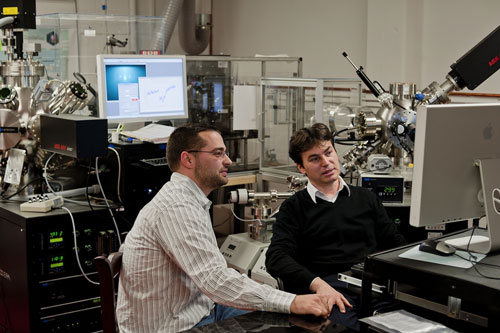| Apr 21, 2011 |
Physicist seeks nanomaterials with rationally designed properties
|
|
(Nanowerk News) A University of Arkansas physicist has received the largest award granted to an individual researcher from the Army Research Laboratory to search for a novel class of nanomaterials with rationally designed properties.
|
|
Physicist Jak Chakhalian seeks to create a new class of materials – so-called topological insulators combined with magnetic and superconductivity properties within just a few atomic layers. From the practical perspective, having all of these properties in one material could lead to building never-before realized topological quantum computers, which could be used to break complex encryption codes and compute things beyond the power of today's supercomputers.
|
 |
| Doctoral student Benjamin Gray, left, and Jak Chakhalian in the laboratory with a unique state-of-the-art piece of equipment built last summer to fabricate atomic layers of complex oxides.
|
|
"If you have that, it will revolutionize the way we think about electrons moving in conventional insulators and metals even at the nanoscale," Chakhalian said. He has funding from the Army Research Laboratory of $1.2 million over five years.
|
|
Recently Chakhalian, associate professor of physics in the J. William Fulbright College of Arts and Sciences, and colleagues found a novel way to "look" at atomic orbitals and found that they change substantially at the interface between a ferromagnet and a high-temperature superconductor. This finding opens up a new way of designing nanoscale superconducting materials. It also fundamentally changes scientific convention, which suggests that only electron spin and atomic charge – not atomic orbitals – influence the properties of nanostructures. It also has profound implications for interfaces between many other complex oxide materials.
|
|
This research was cited by Science magazine as one of the top 10 research breakthroughs of 2007.
|
|
Until recently, researchers only recognized three fundamental types of materials: metals such as iron and gold, insulators and semiconductors. In 2006, theoretical physicists suggested that another completely unknown class of insulating materials might exist. This class, called topological insulators, would not conduct electricity inside the crystal but permits the perfect conduction on the surface within a single atomic layer. This happens because geometry protects the surface electrons. In 2007, scientists looked at the alloy bismuth telluride and found the properties that this theory predicted. They had discovered a new class of material.
|
|
"On the inside, bismuth telluride is an insulator, but on the surface, within one atomic layer, it's a perfect conductor," Chakhalian said. "It will conduct within the single atomic layer no matter how disordered the crystal on the inside. This is a whole new class of materials very similar to the Nobel prize-winning material, graphene, with many other interesting twists."
|
|
Chakhalian wants to create a topological insulator as a nanostructure with magnetic and superconducting properties in a few atomic layers at the interface. He admits that his goal is ambitious, but he likens the research to going to the moon in the 1960s – no one thought it could be done, but it happened.
|
|
"We need scientists to be courageous, to jump into the unknown," he said. Chakhalian will use the grant from the Army Research Laboratory to build new equipment to create and test atomically thin superlattices by combining novel materials and using the interface as a tool.
|
|
Chakhalian is a member of the University of Arkansas Institute for Nanoscience and Engineering. He holds the Charles E. and Clydene Scharlau Endowed Professorship in Chemistry.
|

